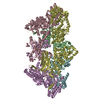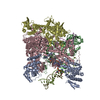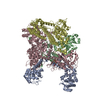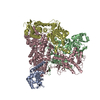+Search query
-Structure paper
| Title | Structural basis of template strand deoxyuridine promoter recognition by a viral RNA polymerase. |
|---|---|
| Journal, issue, pages | Nat Commun, Vol. 13, Issue 1, Page 3526, Year 2022 |
| Publish date | Jun 20, 2022 |
 Authors Authors | Alec Fraser / Maria L Sokolova / Arina V Drobysheva / Julia V Gordeeva / Sergei Borukhov / John Jumper / Konstantin V Severinov / Petr G Leiman /    |
| PubMed Abstract | Recognition of promoters in bacterial RNA polymerases (RNAPs) is controlled by sigma subunits. The key sequence motif recognized by the sigma, the -10 promoter element, is located in the non-template ...Recognition of promoters in bacterial RNA polymerases (RNAPs) is controlled by sigma subunits. The key sequence motif recognized by the sigma, the -10 promoter element, is located in the non-template strand of the double-stranded DNA molecule ~10 nucleotides upstream of the transcription start site. Here, we explain the mechanism by which the phage AR9 non-virion RNAP (nvRNAP), a bacterial RNAP homolog, recognizes the -10 element of its deoxyuridine-containing promoter in the template strand. The AR9 sigma-like subunit, the nvRNAP enzyme core, and the template strand together form two nucleotide base-accepting pockets whose shapes dictate the requirement for the conserved deoxyuridines. A single amino acid substitution in the AR9 sigma-like subunit allows one of these pockets to accept a thymine thus expanding the promoter consensus. Our work demonstrates the extent to which viruses can evolve host-derived multisubunit enzymes to make transcription of their own genes independent of the host. |
 External links External links |  Nat Commun / Nat Commun /  PubMed:35725571 / PubMed:35725571 /  PubMed Central PubMed Central |
| Methods | EM (single particle) / X-ray diffraction |
| Resolution | 3.3 - 4.2 Å |
| Structure data | EMDB-24763: Cryo-EM map of the phage AR9 non-virion RNA polymerase holoenzyme in complex with DNA containing the AR9 P077 promoter EMDB-24765: Cryo-EM map of the phage AR9 non-virion RNA polymerase holoenzyme  PDB-7s00:  PDB-7s01: |
| Chemicals |  ChemComp-ZN: |
| Source |
|
 Keywords Keywords | TRANSCRIPTION / DNA-dependent multisubunit RNA polymerase / deoxyuridine / template strand promoter / RNAP / TRANSCRIPTION/DNA / sigma factor / TRANSCRIPTION-DNA complex / template-strand promoter / sigma-like factor / gp226 |
 Movie
Movie Controller
Controller Structure viewers
Structure viewers About Yorodumi Papers
About Yorodumi Papers







 bacillus phage ar9 (virus)
bacillus phage ar9 (virus)